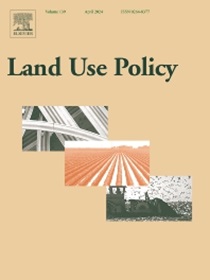中国保护区政策如何考虑社区和社会影响
IF 6
1区 社会学
Q1 ENVIRONMENTAL STUDIES
引用次数: 0
摘要
保护区对于保护生物多样性非常重要。然而,它们也对当地社区产生了许多社会影响,既有消极影响,也有积极影响。保护区管理的有效性会影响所产生的环境和社会影响,以及当地居民对保护措施的态度。鉴于世界各地对保护区社会影响的广泛认识,中国对这一主题的兴趣也日益浓厚,部分原因是中国是一个拥有 11,800 多个保护区的生物多样性大国。基于对官方文件的文献分析和对学术论文的文献综述,我们研究了中国的政策和中国的学术文献是如何考虑与保护区相关的社会影响和当地社区的。我们发现,讨论最多的社会影响与当地社区的收入和生计有关,而文化和当地社区权利等无形社会影响则被忽视或忽略。负面社会影响的报告多于效益的报告。由于长期缺乏对当地社区在保护区管理中潜在作用的考虑,导致社区普遍不参与其中。我们建议进一步考虑当地社区在保护区中的作用,并改进社区参与和利益分享安排。本文章由计算机程序翻译,如有差异,请以英文原文为准。
How communities and social impacts are considered in policies for protected areas in China
Protected areas are important for biodiversity conservation. However, they also create many social impacts on local communities, both negative and positive. The effectiveness of protected area management influences the environmental and social impacts that are created and the attitudes of local people towards conservation initiatives. Given the considerable awareness of the social impacts of protected areas around the world, in China there has now been growing interest in this topic, partly because China is a megadiverse country with over 11,800 protected areas. Based on a document analysis of official documents and a literature review of academic papers, we examine how Chinese policies and the Chinese academic literature consider social impacts and local communities in relation to protected areas. We found that the social impacts most discussed related to the income and livelihoods of local communities, while intangible social impacts, such as culture and the rights of local communities, were neglected or ignored. Negative social impacts were reported more frequently than benefits. The persistent lack of consideration of the potential role of local communities in the management of protected areas has resulted in communities generally being disengaged. We suggest that the role of local communities in protected areas should be further considered, and that community engagement and benefit-sharing arrangements should be improved.
求助全文
通过发布文献求助,成功后即可免费获取论文全文。
去求助
来源期刊

Land Use Policy
ENVIRONMENTAL STUDIES-
CiteScore
13.70
自引率
8.50%
发文量
553
期刊介绍:
Land Use Policy is an international and interdisciplinary journal concerned with the social, economic, political, legal, physical and planning aspects of urban and rural land use.
Land Use Policy examines issues in geography, agriculture, forestry, irrigation, environmental conservation, housing, urban development and transport in both developed and developing countries through major refereed articles and shorter viewpoint pieces.
 求助内容:
求助内容: 应助结果提醒方式:
应助结果提醒方式:


